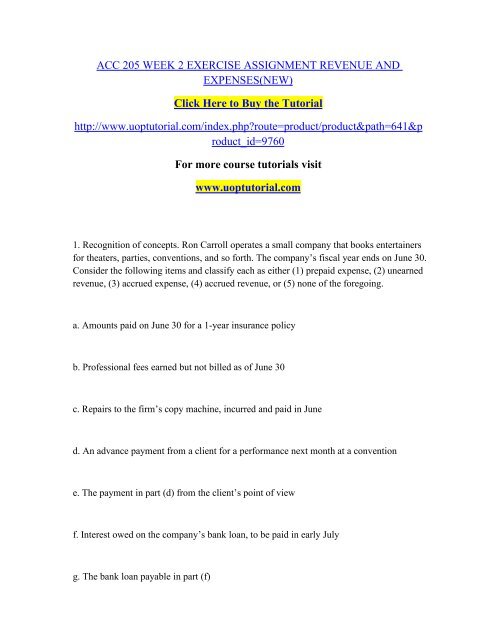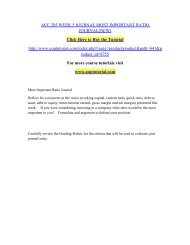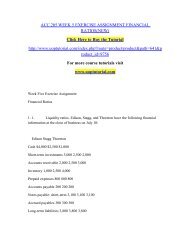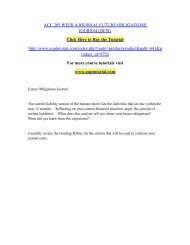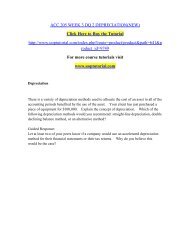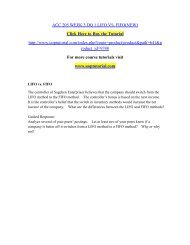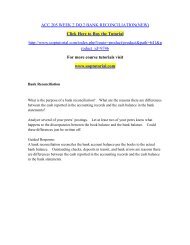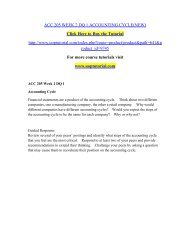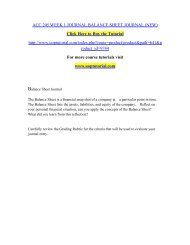ACC 205 WEEK 2 EXERCISE ASSIGNMENT REVENUE AND EXPENSES(NEW)/Uoptutorial
Create successful ePaper yourself
Turn your PDF publications into a flip-book with our unique Google optimized e-Paper software.
<strong>ACC</strong> <strong>205</strong> <strong>WEEK</strong> 2 <strong>EXERCISE</strong> <strong>ASSIGNMENT</strong> <strong>REVENUE</strong> <strong>AND</strong><br />
<strong>EXPENSES</strong>(<strong>NEW</strong>)<br />
Click Here to Buy the Tutorial<br />
http://www.uoptutorial.com/index.php?route=product/product&path=641&p<br />
roduct_id=9760<br />
For more course tutorials visit<br />
www.uoptutorial.com<br />
1. Recognition of concepts. Ron Carroll operates a small company that books entertainers<br />
for theaters, parties, conventions, and so forth. The company’s fiscal year ends on June 30.<br />
Consider the following items and classify each as either (1) prepaid expense, (2) unearned<br />
revenue, (3) accrued expense, (4) accrued revenue, or (5) none of the foregoing.<br />
a. Amounts paid on June 30 for a 1-year insurance policy<br />
b. Professional fees earned but not billed as of June 30<br />
c. Repairs to the firm’s copy machine, incurred and paid in June<br />
d. An advance payment from a client for a performance next month at a convention<br />
e. The payment in part (d) from the client’s point of view<br />
f. Interest owed on the company’s bank loan, to be paid in early July<br />
g. The bank loan payable in part (f)
h. Office supplies on hand at year-end<br />
2. Analysis of prepaid account balance. The following information relates to Action Sign<br />
Company for 20X2:<br />
Insurance expense<br />
$4,350<br />
Prepaid insurance, December 31, 20X2<br />
1,900<br />
Cash outlays for insurance during 20X2<br />
6,200<br />
Compute the balance in the Prepaid Insurance account on January 1, 20X2.<br />
3. Understanding the closing process. Examine the following list of accounts:<br />
Interest Payable
Accumulated Depreciation: Equipment<br />
Alex Kenzy, Drawing<br />
Accounts Payable<br />
Service Revenue<br />
Cash<br />
Accounts Receivable<br />
Supplies Expense<br />
Interest Expense<br />
Which of the preceding accounts<br />
a. appear on a post-closing trial balance?<br />
b. are commonly known as temporary, or nominal, accounts?<br />
c. generate a debit to Income Summary in the closing process?<br />
d. are closed to the capital account in the closing process?
4. Adjusting entries and financial statements. The following information pertains to<br />
Fixation Enterprises:<br />
The company previously collected $1,500 as an advance payment for services to be<br />
rendered in the future. By the end of December, one third of this amount had been earned.<br />
Fixation provided $2,500 of services to Artech Corporation; no billing had been made by<br />
December 31.<br />
Salaries owed to employees at year-end amounted to $1,650.<br />
The Supplies account revealed a balance of $8,800, yet only $3,300 of supplies were<br />
actually on hand at the end of the period.<br />
The company paid $18,000 on October 1 of the current year to Vantage Property<br />
Management. The payment was for 6 months’ rent of Fixation’s headquarters, beginning<br />
on November 1.<br />
Fixation’s accounting year ends on December 31.<br />
Instructions<br />
Analyze the five preceding cases individually and determine the following:<br />
a. The type of adjusting entry needed at year-end (Use the following codes: A, adjustment<br />
of a prepaid expense; B, adjustment of an unearned revenue; C, adjustment to record an<br />
accrued expense; or D, adjustment to record an accrued revenue.)<br />
b. The year-end journal entry to adjust the accounts<br />
c. The income statement impact of each adjustment (e.g., increases total revenues by<br />
$500)
5. Adjusting entries. You have been retained to examine the records of Kathy’s Day Care<br />
Center as of December 31, 20X3, the close of the current reporting period. In the course<br />
of your examination, you discover the following:<br />
On January 1, 20X3, the Supplies account had a balance of $2,350. During the year,<br />
$5,520 worth of supplies was purchased, and a balance of $1,620 remained unused on<br />
December 31.<br />
Unrecorded interest owed to the centertotaled $275 as of December 31.<br />
All clients pay tuition in advance, and their payments are credited to the Unearned<br />
Tuition Revenue account. The account was credited for $75,500 on August 31. With the<br />
exception of $15,500 all amounts were for the current semester ending on December 31.<br />
Depreciation on the school’s van was $3,000 for the year.<br />
On August 1, the center began to pay rent in 6-month installments of $21,000. Kathy<br />
wrote a check to the owner of the building and recorded the check in Prepaid Rent, a new<br />
account.<br />
Two salaried employees earn $400 each for a 5-day week. The employees are paid every<br />
Friday, and December 31 falls on a Thursday.<br />
Kathy’s Day Care paid insurance premiums as follows, each time debiting Prepaid<br />
Insurance:<br />
Date Paid<br />
Policy No.<br />
Length of Policy<br />
Amount<br />
Feb. 1, 20X2
1033MCM19<br />
1 year<br />
$540<br />
Jan. 1, 20X3<br />
7952789HP<br />
1 year<br />
912<br />
Aug. 1, 20X3<br />
XQ943675ST<br />
2 years<br />
840<br />
Instructions<br />
The center’s accounts were last adjusted on December 31, 20X2. Prepare the adjusting<br />
entries necessary under the accrual basis of accounting.<br />
6. Bank reconciliation and entries. The following information was taken from the<br />
accounting records of Palmetto Company for the month of January:<br />
Balance per bank<br />
$6,150
Balance per company records<br />
3,580<br />
Bank service charge for January<br />
20<br />
Deposits in transit<br />
940<br />
Interest on note collected by bank<br />
100<br />
Note collected by bank<br />
1,000<br />
NSF check returned by the bank with the bank statement<br />
650<br />
Outstanding checks<br />
3,080<br />
Instructions:
a. Prepare Palmetto’s January bank reconciliation.<br />
b. Prepare any necessary journal entries for Palmetto.<br />
7. Direct write-off method. Harrisburg Company, which began business in early 20X7,<br />
reported $40,000 of accounts receivable on the December 31, 20X7, balance sheet.<br />
Included in this amount was $550 for a sale made to Tom Mattingly in July. On January 4,<br />
20X8, the company learned that Mattingly had filed for personal bankruptcy. Harrisburg<br />
uses the direct write-off method to account for uncollectibles.<br />
a. Prepare the journal entry needed to write off Mattingly’s account.<br />
b. Comment on the ability of the direct write-off method to value receivables on the<br />
year-end balance sheet.<br />
8. Allowance method: estimation and balance sheet disclosure. The following<br />
pre-adjusted information for the Maverick Company is available on December 31:<br />
Accounts receivable $107,000<br />
Allowance for uncollectible accounts 5,400 (credit balance)<br />
Credit sales 250,000<br />
a. Prepare the journal entries necessary to record Maverick’s uncollectible accounts<br />
expense under each of the following assumptions:<br />
(1) Uncollectible accounts are estimated to be 5% of Credit Sales.<br />
(2) Uncollectible accounts are estimated to be 14% of Accounts Receivable.
. How would Maverick’s Accounts Receivable appear on the December 31 balance<br />
sheet under assumption (1) of part (a)?<br />
c. How would Maverick’s Accounts Receivable appear on the December 31 balance sheet<br />
under assumption (2) of part (a)?<br />
9. Direct write-off and allowance methods: matching approach. The December 31, 20X2,<br />
year-end trial balance of Targa Company revealed the following account information:<br />
Debits<br />
Credits<br />
Accounts Receivable<br />
$252,000<br />
Allowance for Uncollectible Accounts<br />
$ 3,000<br />
Sales<br />
855,000<br />
Instructions<br />
a. Determine the adjusting entry for bad debts under each of the following conditions:
(1) An aging schedule indicates that $12,420 of accounts receivable will be uncollectible.<br />
(2) Uncollectible accounts are estimated at 2% of net sales.<br />
b. On January 19, 20X3, Targa learned that House Company, a customer, had declared<br />
bankruptcy. Present the proper entry to write off House’s $950 balance using the<br />
allowance method.<br />
c. Repeat the requirement in part (b), using the direct write-off method.<br />
d. In light of the House bankruptcy, examine the allowance and direct write-off methods<br />
in terms of their ability to properly match revenues and expenses.<br />
10. Allowance method: analysis of receivables. At a January 20X2 meeting, the president<br />
of Sonic Sound directed the sales staff “to move some product this year.” The president<br />
noted that the credit evaluation department was being disbanded because it had restricted<br />
the company’s growth. Credit decisions would now be made by the sales staff.<br />
By the end of the year, Sonic had generated significant gains in sales, and the president<br />
was very pleased. The following data were provided by the accounting department:<br />
20X2<br />
20X1<br />
Sales<br />
$23,987,000
$8,423,000<br />
Accounts Receivable, 12/31<br />
12,444,000<br />
1,056,000<br />
Allowance for Uncollectible Accounts, 12/31<br />
?<br />
23,000 cr.<br />
The $12,444,000 receivables balance was aged as follows:<br />
Age of Receivable<br />
Amount<br />
Percentage of Accounts Expected to Be Collected<br />
Under 31 days<br />
$5,321,000<br />
99%<br />
31260 days
3,890,000<br />
90<br />
61290 days<br />
1,067,000<br />
80<br />
Over 90 days<br />
2,166,000<br />
60<br />
Assume that no accounts were written off during 20X2.<br />
Instructions<br />
a. Estimate the amount of Uncollectible Accounts as of December 31, 20X2.<br />
b. What is the company’s Uncollectible Accounts expense for 20X2?<br />
c. Compute the net realizable value of Accounts Receivable at the end of 20X1 and 20X2.<br />
d. Compute the net realizable value at the end of 20X1 and 20X2 as a percentage of<br />
respective year-end receivables balances. Analyze your findings and comment on the<br />
president’s decision to close the credit evaluation department.


